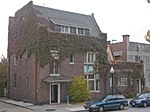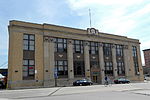North Central Historic District (Baltimore, Maryland)

North Central Historic District is a national historic district in Baltimore, Maryland, United States. It encompasses an area of approximately 25 city blocks situated directly north of downtown Baltimore and includes 630 buildings. The district, which has a roughly triangular-shape, consists of late-19th-century row housing, commercial storefronts from the early 20th century through the 1950s, large industrial buildings, several older theaters, a church, and two school buildings. A broad variety of row house sizes and types reflects the diversity of the neighborhood's residents, ranging from the large and architecturally elaborate dwellings of the upper class to the small alley houses of working-class African Americans.It was added to the National Register of Historic Places in 2002.
Excerpt from the Wikipedia article North Central Historic District (Baltimore, Maryland) (License: CC BY-SA 3.0, Authors, Images).North Central Historic District (Baltimore, Maryland)
North Calvert Street, Baltimore
Geographical coordinates (GPS) Address Nearby Places Show on map
Geographical coordinates (GPS)
| Latitude | Longitude |
|---|---|
| N 39.309444444444 ° | E -76.613333333333 ° |
Address
North Calvert Street 1719
21202 Baltimore
Maryland, United States
Open on Google Maps









